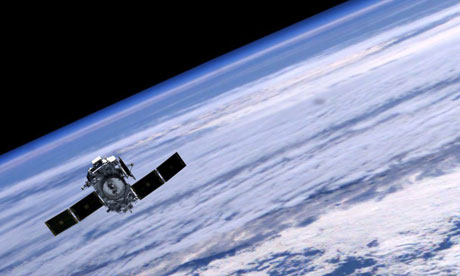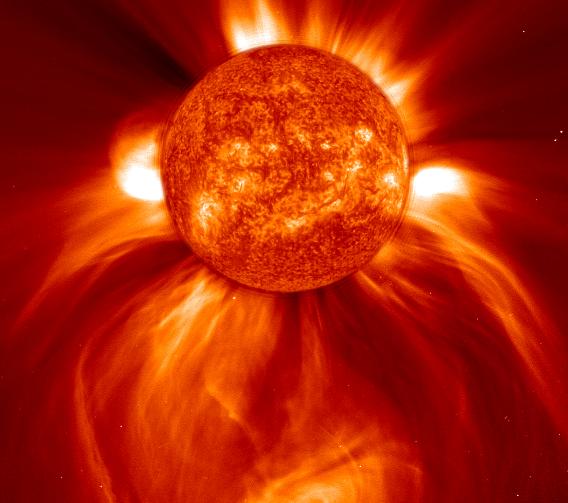Every few decades, though, the sun experiences a particularly large storm. These can release as much energy as 1 billion hydrogen bombs.
The threat of solar storms that could wreak havoc on the world's electronic systems must be taken more seriously, the UK government's chief scientist has warned. A severe solar storm could damage satellites and power grids around the world, he said, leading to a "global Katrina" costing the world's economies as much as $2tn (£1.2tn).
"This issue of space weather has got to be taken seriously," said John Beddington, the UK government's chief scientific adviser, speaking at the annual meeting of the American Association for the Advancement of Science (AAAS) in Washington DC. "We've had a relatively quiet [period] in space weather and we can expect that quiet period to end. Over the same time, over that period, the potential vulnerability
of our systems has increased dramatically. Whether it's the smart grid in our electricity systems or the ubiquitous use of GPS in just about everything these days."
"It's reasonable to expect there will be more [solar storm] events," said Jane Lubchenco, administrator of the US National Oceanic and Atmospheric Administration. "The watchwords are predict and prepare."
The sun's activity goes up and down on a roughly 11-year cycle, and the next period of maximum activity is expected in 2013.
A solar storm starts with a solar flare that is accompanied by a burst of electromagnetic radiation that, when it arrives at Earth, ionises the outer atmosphere. On the ground, we would be safe but GPS satellites and others would be affected.
"GPS is a critical part of almost everything we do," said Thomas Bogdan, director of the Space Weather Prediction Centre in Colorado. "The ubiquitous need for an uninterrupted power supply, satellite-delivered services – every time you go to a gas station and purchase a gallon of gas with your credit card, that's a satellite transaction taking place – and, of course, aviation and communications. We have made our lives increasingly dependent on these things, but each of them carries vulnerabilities to space weather with them."
Around 10-20 minutes after the initial flare would come a burst of energetic protons. "Now at risk would be satellites at geostationary orbit – if they do not have sufficient shielding around their sensitive electronics, they could be subject to problems with the internal computational activities," said Bogdan.
Around 10-30 hours later, a "coronal mass ejection" would hit the Earth's magnetosphere and cause electric currents to surge along oil pipelines and high-tension electricity lines. This could cause blackouts such as the one that occurred in Quebec in 1989. Around large parts of the world, people would see a lightshow in the sky similar to the aurora borealis.
Lubchenco said last week's solar flare illustrated the importance of paying close attention to solar weather. "That was the strongest solar flare in four years," she said. "As a consequence, airlines rerouted flights from polar regions in anticipation of the possibility that their radio communications would not be operational. That resulted in individuals being bumped from those flights, increased cost to the airlines because of longer routes and more use of fuel."
Bogdan said the time it takes for the worst aspects of a solar storm to travel between the sun to Earth gives authorities a window of opportunity to get ready for the coming electromagnetic disturbances. Power companies could prepare by hardening transformers at substations and installing capacitors to soak up current surges.
The most severe solar storm on record occurred in 1859, but there was little electric infrastructure in place around the world at the time. The storm did send currents running along the newly built telegraph systems, however. "They were so strong that the operators of the telegraphs could disconnect their batteries and still start sending messages," said Bogdan.
The threat of solar storms that could wreak havoc on the world's electronic systems must be taken more seriously, the UK government's chief scientist has warned. A severe solar storm could damage satellites and power grids around the world, he said, leading to a "global Katrina" costing the world's economies as much as $2tn (£1.2tn).
"This issue of space weather has got to be taken seriously," said John Beddington, the UK government's chief scientific adviser, speaking at the annual meeting of the American Association for the Advancement of Science (AAAS) in Washington DC. "We've had a relatively quiet [period] in space weather and we can expect that quiet period to end. Over the same time, over that period, the potential vulnerability
of our systems has increased dramatically. Whether it's the smart grid in our electricity systems or the ubiquitous use of GPS in just about everything these days."
"It's reasonable to expect there will be more [solar storm] events," said Jane Lubchenco, administrator of the US National Oceanic and Atmospheric Administration. "The watchwords are predict and prepare."
The sun's activity goes up and down on a roughly 11-year cycle, and the next period of maximum activity is expected in 2013.
A solar storm starts with a solar flare that is accompanied by a burst of electromagnetic radiation that, when it arrives at Earth, ionises the outer atmosphere. On the ground, we would be safe but GPS satellites and others would be affected.
"GPS is a critical part of almost everything we do," said Thomas Bogdan, director of the Space Weather Prediction Centre in Colorado. "The ubiquitous need for an uninterrupted power supply, satellite-delivered services – every time you go to a gas station and purchase a gallon of gas with your credit card, that's a satellite transaction taking place – and, of course, aviation and communications. We have made our lives increasingly dependent on these things, but each of them carries vulnerabilities to space weather with them."
Around 10-20 minutes after the initial flare would come a burst of energetic protons. "Now at risk would be satellites at geostationary orbit – if they do not have sufficient shielding around their sensitive electronics, they could be subject to problems with the internal computational activities," said Bogdan.
Around 10-30 hours later, a "coronal mass ejection" would hit the Earth's magnetosphere and cause electric currents to surge along oil pipelines and high-tension electricity lines. This could cause blackouts such as the one that occurred in Quebec in 1989. Around large parts of the world, people would see a lightshow in the sky similar to the aurora borealis.
Lubchenco said last week's solar flare illustrated the importance of paying close attention to solar weather. "That was the strongest solar flare in four years," she said. "As a consequence, airlines rerouted flights from polar regions in anticipation of the possibility that their radio communications would not be operational. That resulted in individuals being bumped from those flights, increased cost to the airlines because of longer routes and more use of fuel."
Bogdan said the time it takes for the worst aspects of a solar storm to travel between the sun to Earth gives authorities a window of opportunity to get ready for the coming electromagnetic disturbances. Power companies could prepare by hardening transformers at substations and installing capacitors to soak up current surges.
The most severe solar storm on record occurred in 1859, but there was little electric infrastructure in place around the world at the time. The storm did send currents running along the newly built telegraph systems, however. "They were so strong that the operators of the telegraphs could disconnect their batteries and still start sending messages," said Bogdan.



Comments
Post a Comment